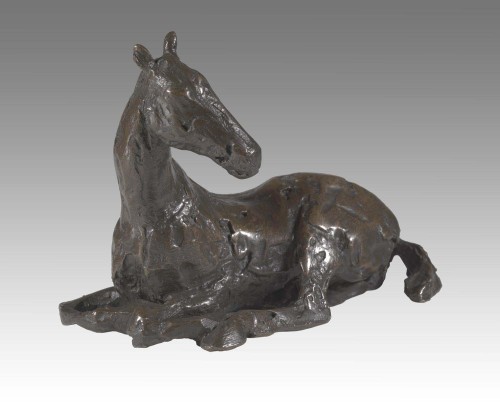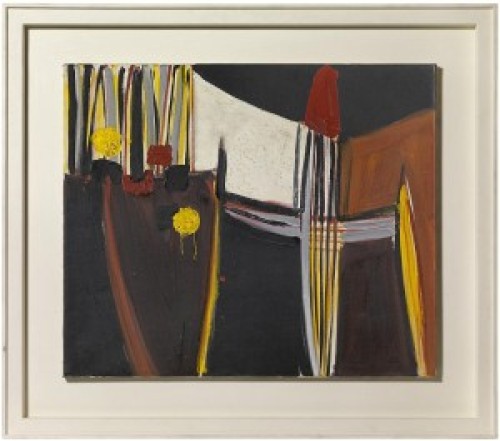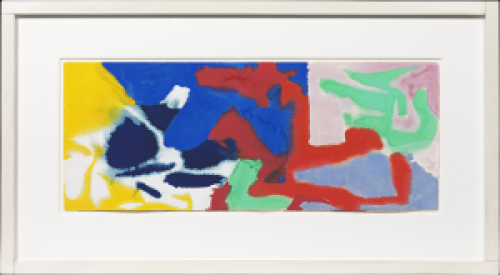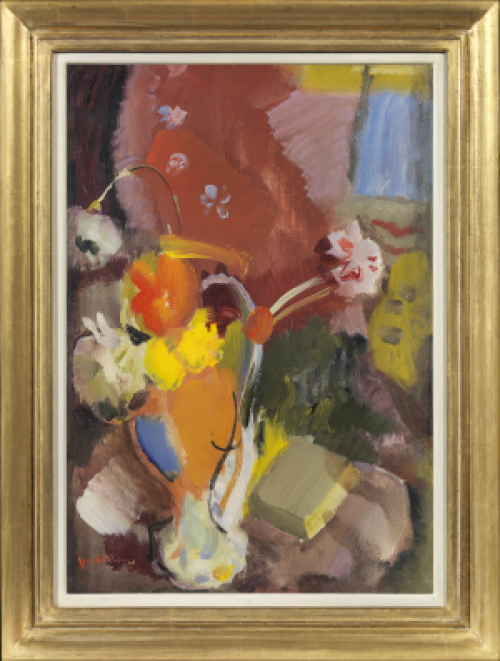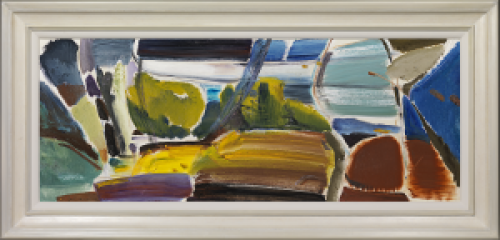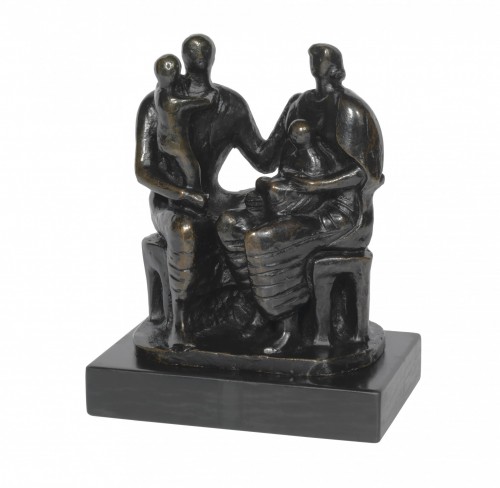DAME BARBARA HEPWORTH DBE
Wakefield 1903 - 1975 St Ives
Ref: CA 134
Hollow oval (January)
Signed with initials, numbered and inscribed with the foundry mark on the base: M/S B.H. 7/9
Polished bronze with a green patina in the interior and strings:
5 x 7 ½ x 3 in / 12.7 x 19 x 7.6 cm
On a bronze base: ½ x 5 x 3 ¾ in / 1.3 x 12.7 x 9.5 cm
Conceived and cast in 1965 from a plaster prototype by the Morris Singer Foundry, London in a numbered edition of 9+0
BH 375
Provenance:
Governor Nelson A Rockefeller (1908-1979), New York, purchased through Marlborough Gerson Gallery, 1966; then by descent to
Mrs Nelson A Rockefeller, New York;
Christie’s London, 21st November 2013, lot 199;
private collection, acquired from the above
Exhibited:
London, Gimpel Fils, Collectors’ Choice XIII, March-April 1965, no.46, another cast
New York, Marlborough-Gerson, Barbara Hepworth, April-May 1966, no.27
London, Tate Gallery, Barbara Hepworth, 3rd April-19th May 1968, no.148 another cast
Literature:
Herbert Read (intro), Barbara Hepworth: Exhibition of Sculpture, exh. cat., Marlborough Gerson Gallery, New York 1966, no.27, illus.
Ronald Alley (intro), Barbara Hepworth Retrospective 1927-67, Tate Gallery, London 1968, pp.41, 60, no.148, another cast illus. p.40
Alan Bowness (ed.), The Complete Sculpture of Barbara Hepworth 1960-69, Lund Humphries, London 1971, no.375, another cast illus. p.39
Alan G Wilkinson, Barbara Hepworth: The Art Gallery of Ontario Collection, Ontario 1991, pp.22, 46, no.13, another cast illus. p.36
This work will be included as BH 375 in the forthcoming catalogue raisonné of Barbara Hepworth’s sculptures being revised by Dr Sophie Bowness.
Cast 9 is owned by Cornwall Council Schools Art Collection and the Art Gallery of Ontario has cast 8.
Hollow oval (January) is an exquisite, small-scale sculpture demonstrating the vital contrasts first explored by Hepworth in the 1930s and perfected in later years at the height of her powers. Hepworth skillfully juxtaposes the smooth, warm gold of the polished external surface with the deep green patination of the interior concavity. To the right, a cylindrical hole tilts and tapers towards the back opening up the solid form further, uniting the spaces in front and behind the sculpture. The soft curves of the horizontal, half ovoid and circular piercing are balanced by the linear tension of the strings, which converge inside the piercing before radiating out to the edge of the interior on the right and crossing back over the open face of the sculpture towards the left in evenly spaced horizontal lines. The striking contrasts between interior and exterior, mass and space, organic and constructive form, represent some of the central themes of Hepworth’s career, giving this work incredible depth and heightening our perception of each remarkable element.
Hepworth introduced interior colour and stringing to her work in the late 1930s, soon after relocating to Cornwall, creating plaster maquettes such as Sculpture with colour (deep blue and red) (2), 1940 (Tate) and later the carved wood, Sculpture with colour (oval form) pale blue and red, 1943 (private collection) and Oval sculpture, 1943 (The Pier Arts Centre, Stromness). The artist described how the extraordinary landscape of Cornwall and her experience of it, became the inspiration for most of her subsequent work: ‘It was during this time that I gradually discovered the remarkable pagan landscape which lies between St Ives, Penzance and Land’s End; a landscape which still has a very deep effect on me, developing all my ideas about the relationship of the human figure in landscape - sculpture in landscape and the essential quality of light in relation to sculpture which induced a new way of piercing the forms to contain colour.’[1] Hepworth continued, ‘The colour in the concavities plunged me into the depth of water, caves, or shadows deeper than the carved concavities themselves. The strings were the tension I felt between myself and the sea, the wind or the hills.’[2]
Matthew Gale suggests the ovoid form relates to ‘Hepworth’s long-standing concerns with the cycles of nature and the promise of rebirth. She shared these themes with Brancusi, whose studio had so impressed her in 1933 and whose work drew upon the egg’s formal purity and conceptual complexity…In 1946, at a time when she first exhibited the carved version of Oval sculpture 1943, she recognized in her early work the ‘simple realistic oval forms of the human head or of a bird.’ Oval form with strings and colour [1966, The MET, New York] continued this passage from realism to abstract form.’[3] Highlighting the extensive range and scale in the artist’s work during the 1960s, Hepworth also created the monumental Single form (1961– 64) at this time, commissioned for the United Nations building in New York as a memorial to the Secretary General, Dag Hammarskjöld, which confirmed her international standing. In 1965 a retrospective of her work was held at the Rietveld Pavilion, Rijksmusem Kröller-Müller, Otterloo in The Netherlands, she was made a Dame Commander of the British Empire and appointed the first female Trustee of the Tate Gallery.
Writing on the occasion of Hepworth’s 1968 retrospective at the Tate, in which a cast of the present work was exhibited, Ronald Alley states, ‘looking at Barbara Hepworth’s recent work we can see that it is more varied than that of any of her earlier periods, with possibilities leading in a number of different directions. For she is an artist who is constantly building on her own achievement by developing and enriching it…there are bronzes, some large with rough surfaces and greenish patinas, others small and beautifully polished and gleaming…tiny polished bronzes which are like precious objects to be kept on shelves. There are small intimate ‘hand sculptures’, small enough to be carried about and appealing to the sense of touch as well as to the eyes…in these works this brave and indefatigable woman transcends the difficulties and ugliness of modern life and evokes a vision of radiant calm perfection.’[4]
This exceptional sculpture was originally owned by Governor Nelson A Rockefeller (1908-1979), purchased through the Marlborough Gerson Gallery, New York in 1966. The grandson of Standard Oil founder, John D Rockefeller, Nelson Aldrich Rockefeller was an American
businessman and politician, who became the 49th Governor of New York from 1958 to 1973. He was the 41st Vice President of the United States from December 1974-January 1977, under President Gerald Ford following Richard Nixon’s resignation. A noted art collector, he also promoted public access to the arts and served as trustee, treasurer and president of the Museum of Modern Art, New York and founded the Museum of Primitive Art in 1954, giving the museum’s collection to the Metropolitan Museum of Art in 1969, where it became the Michael C Rockefeller Collection. Rockefeller created the first State Council on the Arts in the country, which became a model for the National Endowment for the Arts. He also served as Chairman of Rockefeller Center, Inc., from 1945-53 and 1956-58.
[1] The artist, Barbara Hepworth: Carving and Drawings, Lund Humphries, London 1952 cited in Barbara Hepworth. Writings and Conversations, Sophie Bowness (ed.), Tate Publishing, London 2015, pp.67-68.
[2] The artist, ibid.
[3] Mathew Gale and Chris Stephens, Barbara Hepworth, Works in the Tate Collection and the Barbara Hepworth Museum St Ives, Tate Publishing, London, 1999, p.236.
[4] Ronald Alley, ‘Barbara Hepworth’s artistic development’, Barbara Hepworth, exh cat, Tate, London, 1968.







